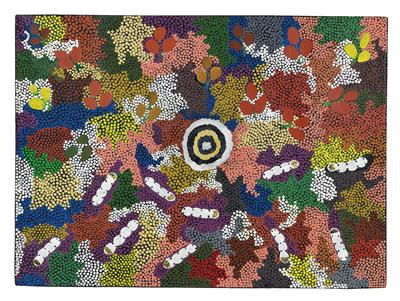Australia, Aborigines: ‘Bush Tucker. Looking for food’ Is the title of this picture by the Aboriginal artist Cynthia Watson. Painted in the typical painting technique of the Australian original peoples, the ‘dot painting’ technique. Circa 1990s.
Australia, Aborigines: ‘Bush Tucker. Looking for food’ Is the title of this picture by the Aboriginal artist Cynthia Watson. Painted in the typical painting technique of the Australian original peoples, the ‘dot painting’ technique. Circa 1990s.

In 1971/1972, the ‘white’ Australian art teacher Geoffrey Bardon encouraged the Aborigines in a reservation in Papunya, north-west of Alice Springs (central Australia, in the state of Northern Territory) to paint their pictures, which they normally drew in sand, on pieces of bark or on their bodies and objects of daily life, on rectangular canvases with synthetic colours. This was the birth of modern ‘Aboriginal painting’. Since then the art of the Australian native peoples has enjoyed a real triumph in the international art world. There have been many exhibitions throughout the world. The Austrian private museum Essl in Klosterneuburg possesses a rich inventory of Aboriginal painting. Cynthia Watson is a young Aboriginal artist. She also comes from the area northwest of Alice Springs, which is inhabited by the tribes of the Warlpiri and Arrernte. Cynthia Watson paints in the ‘dot painting technique’, that has frequently appeared since the 1980s in the modern art of Australian native peoples. In her painting ‘Bush Tucker. Looking for food’ she addresses the difficult, daily search for food of the Aboriginal women in earlier times: Cynthia Watson paints a diverse and multi-coloured landscape from a bird’s eye perspective, as so often employed by Aboriginal artists. The concentric circles in the middle represent a fireplace or an encampment. In the upper half of the painting one sees bushes that bear fruit (or berries). In the lower half one can recognise ten thick, fat white larvae or grubs which once belonged to the diet of the Australian native peoples and which were collected by the women. A typical Aboriginal painting on canvas and on black ground, painted after 1990. Title and signature on the reverse of the canvas. Dimensions: 60 x 80 cm (the picture alone). (ME)
Esperto: Prof. Erwin Melchardt
 Prof. Erwin Melchardt
Prof. Erwin Melchardt
+43-1-515 60-465
erwin.melchardt@dorotheum.at
02.11.2015 - 14:00
- Prezzo di partenza:
-
EUR 500,-
Australia, Aborigines: ‘Bush Tucker. Looking for food’ Is the title of this picture by the Aboriginal artist Cynthia Watson. Painted in the typical painting technique of the Australian original peoples, the ‘dot painting’ technique. Circa 1990s.
In 1971/1972, the ‘white’ Australian art teacher Geoffrey Bardon encouraged the Aborigines in a reservation in Papunya, north-west of Alice Springs (central Australia, in the state of Northern Territory) to paint their pictures, which they normally drew in sand, on pieces of bark or on their bodies and objects of daily life, on rectangular canvases with synthetic colours. This was the birth of modern ‘Aboriginal painting’. Since then the art of the Australian native peoples has enjoyed a real triumph in the international art world. There have been many exhibitions throughout the world. The Austrian private museum Essl in Klosterneuburg possesses a rich inventory of Aboriginal painting. Cynthia Watson is a young Aboriginal artist. She also comes from the area northwest of Alice Springs, which is inhabited by the tribes of the Warlpiri and Arrernte. Cynthia Watson paints in the ‘dot painting technique’, that has frequently appeared since the 1980s in the modern art of Australian native peoples. In her painting ‘Bush Tucker. Looking for food’ she addresses the difficult, daily search for food of the Aboriginal women in earlier times: Cynthia Watson paints a diverse and multi-coloured landscape from a bird’s eye perspective, as so often employed by Aboriginal artists. The concentric circles in the middle represent a fireplace or an encampment. In the upper half of the painting one sees bushes that bear fruit (or berries). In the lower half one can recognise ten thick, fat white larvae or grubs which once belonged to the diet of the Australian native peoples and which were collected by the women. A typical Aboriginal painting on canvas and on black ground, painted after 1990. Title and signature on the reverse of the canvas. Dimensions: 60 x 80 cm (the picture alone). (ME)
Esperto: Prof. Erwin Melchardt
 Prof. Erwin Melchardt
Prof. Erwin Melchardt
+43-1-515 60-465
erwin.melchardt@dorotheum.at
|
Hotline dell'acquirente
lun-ven: 10.00 - 17.00
kundendienst@dorotheum.at +43 1 515 60 200 |
| Asta: | Tribal Art |
| Tipo d'asta: | Asta in sala |
| Data: | 02.11.2015 - 14:00 |
| Luogo dell'asta: | Wien | Palais Dorotheum |
| Esposizione: | 28.10. - 02.11.2015 |
